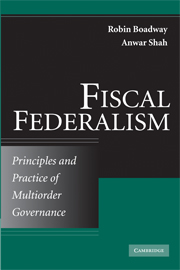PART ONE - DESIGNING FISCAL CONSTITUTIONS
Published online by Cambridge University Press: 05 June 2012
Summary
Part I is concerned with division of fiscal powers in federal systems. Seven chapters are devoted to various aspects of assignment of spending, taxing, and regulatory powers among various orders of government.
Chapter 1 introduces basic concepts of federalism. It distinguishes between unitary and federal forms of constitutions and presents a stylized view of alternate models of federalism in theory and practice. It identifies the sources of inefficiency and inequity in a market economy and outlines the rational for public intervention. It argues that ultimately the assignment of powers in a federation and the optimal policies undertaken by each level of government depend on the same efficiency and equity considerations that determine the rationale for government intervention in the first place. Because federal economies consist of various autonomous jurisdictions, however, there are additional efficiency and equity considerations, some of which arise because decentralization has different effects on the fiscal capacities of different subnational jurisdictions, giving rise to fiscal inefficiencies and fiscal inequities. Others arise because of horizontal fiscal externalities, as the independent policies of governments at a given level have effects on residents or governments of neighboring jurisdictions. Still others arise when policies undertaken at a given level of government affect governments at another level, creating what are known as vertical fiscal externalities. The existence of these various effects will influence the case for decentralization, as they represent costs of decentralization that must be set against the many benefits.
- Type
- Chapter
- Information
- Fiscal FederalismPrinciples and Practice of Multiorder Governance, pp. 1 - 3Publisher: Cambridge University PressPrint publication year: 2009



